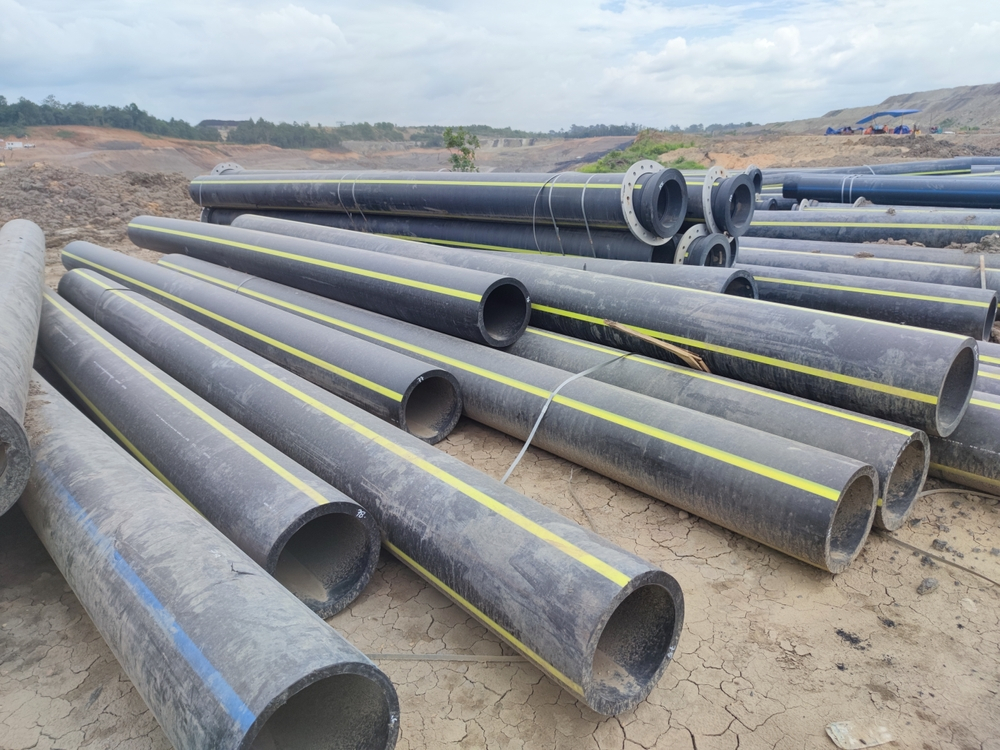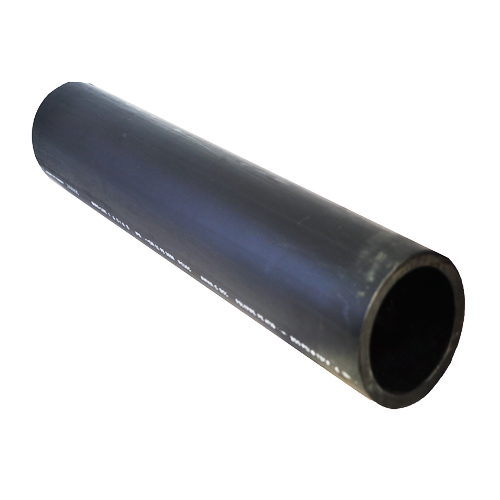Texas hdpe pipe manufacturer: Sustainable Innovations
Wiki Article
Check Out the Production Process Behind High-Quality HDPE Pipeline and Its Applications
The production process of top notch HDPE pipelines is elaborate and systematic. It starts with the option of raw products that enhance performance. Following this, ethylene undergoes polymerization to form resin, which is then formed through extrusion. Quality assurance is critical, making certain that the end product satisfies rigorous standards. The journey of HDPE pipelines doesn't end with manufacturing. Their applications across different sectors expose a broader value worth taking a look at.Understanding HDPE: Characteristics and Advantages

High-density polyethylene (HDPE) is a functional polycarbonate known for its sturdiness and resistance to various ecological factors. This material displays exceptional tensile toughness, making it appropriate for demanding applications. Its low-density structure adds to a light-weight item, facilitating ease of dealing with and setup. HDPE likewise showcases remarkable resistance to chemicals, which minimizes degradation when exposed to harsh substances.
The product's low wetness absorption even more boosts its durability, making it suitable for usage in pipelines and tank. Furthermore, HDPE is resistant to ultraviolet (UV) radiation, making certain that items preserve their stability also when subjected to sunlight. Its flexibility allows for the creation of intricate forms without jeopardizing strength. The environment-friendly nature of HDPE, commonly stemmed from recycled materials, contributes to its appeal, advertising sustainable methods in manufacturing. Overall, these buildings and benefits make HDPE a favored selection for various commercial and consumer applications.
Basic Material Option for HDPE Manufacturing
The choice of resources for HDPE production is necessary to verify the end product fulfills the desired requirements and quality criteria. High-density polyethylene (HDPE) is mostly created from polymerized ethylene, acquired from fossil fuels such as gas or crude oil. The quality of these feedstocks significantly affects the mechanical and thermal residential properties of the final HDPE.Additives additionally play a substantial duty in boosting HDPE's efficiency, including anti-oxidants, UV stabilizers, and colorants, which enhance toughness and resistance to ecological variables. The option procedure should consider not only the chemical composition of the raw products yet also their handling features to assure reliable manufacturing.
The sourcing of raw materials must focus on sustainability and conformity with ecological guidelines, as accountable practices are crucial in today's market. Ultimately, mindful basic material choice lays the structure for creating high-quality HDPE pipes suitable for diverse applications.
The Extrusion Process: Forming HDPE Pipe
The extrusion procedure plays a vital duty fit HDPE pipes, starting with careful product prep work strategies that assure ideal flow and uniformity. Just as vital is the style of the die, which straight affects the final measurements and surface high quality of the pipeline. With each other, these elements contribute significantly to the performance and top quality of HDPE pipeline manufacturing.Material Preparation Strategies
Reliable manufacturing of HDPE pipelines begins with meticulous product prep work strategies, specifically the extrusion process. Throughout this phase, high-density polyethylene material is initial dried to remove dampness, ensuring ideal flow features. The material is then fed right into the extruder, where it goes through home heating and melting, changing right into a thick state. This home heating process is very carefully managed to keep the material's integrity and efficiency. The liquified HDPE is compelled with a die, forming it right into a constant pipe type. Appropriate temperature level administration throughout extrusion is necessary, as it straight impacts the product's residential or commercial properties and the final item high quality. When shaped, the HDPE pipe is cooled and reduced to specified sizes, prepared for succeeding processing and applications.Die Style Value
Precision in die style plays a vital duty in the extrusion procedure of HDPE pipes. The die works as the final shaping device, directly influencing the pipe's dimensions, wall surface density, and surface coating. A well-designed die warranties consistent product circulation, minimizing defects such as irregularities and weak points. The geometry of the die should be optimized to suit the particular buildings of HDPE, including its viscosity and thermal habits throughout extrusion. Furthermore, the cooling price of the material as it travels through the die can significantly influence the pipe's structural stability. Investing in sophisticated die innovation is essential for suppliers aiming to generate premium HDPE pipelines that meet market requirements and consumer assumptions.High Quality Control Measures in HDPE Production
Although numerous aspects affect the top quality of HDPE pipeline manufacturing, efficient quality assurance measures are vital to assure uniformity and integrity in the end product. Key quality assurance methods include extensive material evaluation, validating that the raw polyethylene meets well-known standards for pureness and thickness. Throughout the extrusion process, specifications such as temperature, stress, and cooling time are carefully kept track of to keep dimensional accuracy and structural honestyIn addition, post-production screening is important; manufacturers frequently carry out hydrostatic tests to examine the pipeline's toughness and resistance to stress. Visual inspections for surface area flaws further boost top quality guarantee. Accreditation from appropriate criteria organizations, like ASTM or ISO, offers an added layer of trustworthiness. By executing these detailed quality control procedures, manufacturers can lessen problems, boost performance, and make sure that the HDPE pipelines satisfy the specific demands of numerous applications, ultimately bring about consumer satisfaction and count on in the item.
Applications of HDPE Pipeline Throughout Industries
HDPE pipelines are utilized across various markets because of their resilience and adaptability. In water circulation systems, they assure efficient delivery, while in wastewater administration, they provide trustworthy services for waste transportation. Additionally, agricultural irrigation networks profit from HDPE's resistance to deterioration and adaptability, making it an optimal option for contemporary farming methods.
Water Circulation Systems
A considerable variety of industries depend on high-density polyethylene (HDPE) pipes for efficient water distribution systems. Known for their durability and resistance to rust, HDPE pipes are widely utilized in local supply of water networks, agricultural irrigation, and commercial applications. Their lightweight nature promotes very easy handling and installation, minimizing labor prices and time. Additionally, HDPE pipes can suit various pressure degrees, making them suitable for both reduced and high-pressure systems. American Plastics HDPE Pipe why not look here for Oilfield. The flexibility of the material permits for smooth integration right into existing facilities, lessening the requirement for substantial excavation. Furthermore, HDPE's resistance to chemical leaching guarantees that the water delivered remains safe and tidy, making it an optimal option for preserving the high quality of safe and clean water throughout numerous fieldsWastewater Monitoring Solutions
Effective water circulation systems additionally lead the way for innovative wastewater management remedies, where high-density polyethylene (HDPE) pipes play a considerable function. Prominent for their durability and resistance to corrosion, HDPE pipes are perfect for transporting wastewater in numerous settings. Their versatility permits very easy installment in complicated environments, decreasing the need for substantial excavation. Furthermore, HDPE's smooth indoor surface area decreases friction, enhancing circulation prices and performance. These pipes are also resistant to chemical leaching, making certain that contaminants do not jeopardize the surrounding atmosphere. Industries, municipalities, and treatment centers increasingly count on HDPE pipelines for their integrity and long life, making them a preferred option for contemporary wastewater administration systems. This versatility underscores the critical significance of HDPE pipes throughout many applications.Agricultural Watering Networks
Agricultural irrigation networks benefit considerably from the usage of high-density polyethylene (HDPE) pipes, which offer reliable and dependable water shipment to crops. HDPE pipelines are light-weight, making them simple to carry and set up, while their adaptability permits for various setups in diverse surfaces. These pipelines demonstrate outstanding resistance to rust, chemicals, and UV radiation, making certain sturdiness in severe agricultural settings. Furthermore, their smooth interior surface area lessens rubbing loss, maximizing water circulation and minimizing power costs related to pumping. The longevity of HDPE pipes, commonly exceeding half a century, contributes to decrease maintenance and substitute costs. Farmers progressively depend on HDPE pipes to boost watering performance and advertise sustainable agricultural techniques, eventually leading to improved plant returns and source preservation.
Future Fads in HDPE Pipeline Innovation
As the need for lasting and effective facilities grows, developments in HDPE pipe innovation are poised to change various industries. Emerging fads include the assimilation of wise innovations, such as sensors and IoT capabilities, which help with real-time monitoring of pipeline conditions, decreasing upkeep expenses and stopping leaks. Additionally, the development of advanced manufacturing strategies, such as 3D printing, is enabling the production of complex, personalized pipe layouts that deal with particular task demands.Moreover, the emphasis on recycling and round economic situation techniques is driving the development of HDPE pipes made from recycled products, enhancing sustainability. Improved jointing approaches, such as electro-fusion and mechanical installations, are also boosting installation performance and reliability. The growing focus on ecological policies is pressing manufacturers to embrace greener production procedures, making sure that HDPE pipes not just meet industry criteria however also cultivate an even more sustainable future for infrastructure growth.
Regularly Asked Questions
How Does HDPE Contrast to Various Other Plastic Materials?
HDPE exceeds several wikipedia reference various other plastic products regarding toughness, chemical resistance, and flexibility. Its low thickness and high tensile stamina make it optimal for various applications, usually exceeding alternatives in both performance and long life.What Are the Environmental Influences of HDPE Production?
The environmental influences of HDPE manufacturing consist of greenhouse gas discharges, power consumption, and prospective air pollution from producing processes. Additionally, inappropriate disposal can bring about soil and water contamination, increasing concerns about long-term ecological results.Can HDPE Pipes Be Recycled?
Yes, HDPE pipes can be over here reused. Several centers accept used HDPE for processing, transforming it right into brand-new products. This reusing adds to sustainability efforts, reducing plastic waste while saving resources and energy in the production cycle.What Is the Life Expectancy of HDPE Water Lines?

Just How Do Temperature Variations Affect HDPE Pipeline Efficiency?
Temperature variants greatly impact HDPE pipeline efficiency, influencing adaptability and strength. Heats can cause softening, while reduced temperature levels might cause brittleness, ultimately influencing the pipeline's longevity and viability for various applications in diverse settings.Report this wiki page